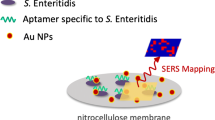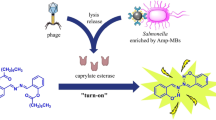Abstract
Present work demonstrates effective utilization of functionalized polymeric fluorescent nanoparticles as biosensing probe for the detection of Salmonella typhi bacteria on modified polycarbonate (PC) filters in about 3 h. Antibody modified-PC membranes were incubated with contaminated bacterial water for selective capturing which were detected by synthesized novel bioconjugate probe. Core–shell architecture of polymeric nanoparticles endows them with aqueous stabilization and keto-enolic functionalities making them usable for covalently linking S. typhi antibodies without any crosslinker or activator. Bradford analysis revealed that one nanoparticle has an average of 3.51 × 10−19 g or 21 × 104 bound S. typhi Ab molecules. Analysis of the regions of interest (ROI) in fluorescent micrographs of modified fluoroimmunoassay showed higher detection sensitivity of 5 × 102 cells/mL due to signal amplification unlike conventional naked dye FITC-Ab conjugate. Fluorescence of pyrene dye remained same on immobilization of biomolecules and nanoparticles showed stable fluorescent intensity under prolong exposure to laser owing to protective polymeric layer allowing accurate identification of bacteria. Surface-functionalized PC matrix and fluorescent label NPs permit covalent interactions among biomolecules enhancing signal acquisitions showing higher detection efficiency as compared to conventional microtiter plate-based system. Our novel immunoassay has the potential to be explored as rapid detection method for identifying S. typhi contaminations in water.
Graphical Abstract







Similar content being viewed by others
Abbreviations
- FPNP:
-
Fluorescent polymeric nanoparticles
- NPs:
-
Nanoparticles
- AAEM:
-
Acetoacetoxy ethyl methacrylate
- S. typhi :
-
Salmonella typhi
- Ab:
-
Antibody
- Fl:
-
Fluorescent
References
Abdel-Hamid I, Ghindilis AL, Atanasov P, Wilkins E (1998) Development of a flow-through immunoassay system. Sens Actuat B 49:202–210
Allmer K, Huly A, Runby B (1989) Surface modification of polymers. III. Grafting of stabilizers onto polymer films. J Polym Sci Part A 27:3405–3417
Bagwe RP, Hilliard LR, Tan W (2006) Surface modification of silica nanoparticles to reduce aggregation and non-specific binding. Langmuir 25:4357–4362
Chen CS, Durst RA (2006) Simultaneous detection of Escherichia Coli and O157:H7, Salmonella spp. and Listeria monocytogenes with an array-based immunosorbent assay using universal protein G liposomal nanovesicles. Talanta 69:232–238
Chen L, Zhang J (2012) Bioconjugated magnetic nanoparticles for rapid capture of gram-positive Bacteria. J Biosens Bioelectrons 11:005
Cheng CM, Martinez A, Gong J, Mace CR, Phillips ST, Carrilho E, Mirica K, Whitesides G (2010) Paper-based ELISA. Angew Chem Int Ed 49:4771–4774
Chumyim P, Rijiravanich P, Somasundrum M, Surareungchai W (2014) Detection of Salmonella enterica serovar Typhimurium in milk sample using electrochemical immunoassay and enzyme amplified labeling. Int Conf Agric Environ Biol Sci 24–25 Phuke
Gruber HJ, Hahn CD, Kada G, Riener CK, Harms GS, Ahrer W, Dax TG, Knaus HG (2000) Anomalous fluorescence enhancement of Cy3 and Cy3.5 versus anomalous fluorescence loss of Cy5 and Cy7 upon covalent linking to IgG and noncovalent binding to avidin. Bioconjugate Chem 11:696–704
Harma H, Pelkkikangas A, Soukka T, Huhtinen P, Huopalahti S, Lovgern T (2003) Sensitive miniature single-particle immunoassay of prostate-specific antigen using time-resolved fluorescence. Anal Chim Acta 482:157–164
Holzapfel V, Musyanovych A, Landfaster K, Lorenz MR, Mailander V (2005) Preparation of fluorescent carboxyl and amino functionalized polystyrene particles by miniemulsion polymerization as markers for cells. Macromol Chem Phys 206:2440–2449
Hun X, Zhang Z (2007a) A novel sensitive staphylococcal enterotoxin C1 fluoroimmunoassay based on functionalized fluorescent core-shell nanoparticle labels. Food Chem 105:1623–1629
Hun X, Zhang Z (2007b) Fluoroimmunoassay for tumor necrosis factor- α in human serum using Ru(bpy)3Cl2-doped fluorescent silica nanoparticles as labels. Talanta 73:366–371
Hun X, Zhang Z, Tiao L (2008) Anti-Her-2 monoclonal antibody conjugated polymer fluorescent nanoparticles probe for ovarian cancer imaging. Anal Chim Acta 625:201–206
Ivnitski D, Abdel-Hamid I, Atanasov P, Wilkins E (1999) Biosensors for detection of pathogenic bacteria. Biosens Bioelectron 14:599–624
Jain S, Chattopadhyay S, Jackeray R, Abid Z, Singh H (2013) Novel functionalized fluorescent polymeric nanoparticles: synthesis, characterization and immobilization of biomolecules. Nanoscale 5:6883–6892
Kumar S, Balakrishna K, Batra HV (2008) Enrichment-ELISA for detection of Salmonella typhi from food and water samples. Biomed Environ Sci 21(2):137–143
Kumari A, Yadav SK, Yadav SC (2010) Biodegradable polymeric nanoparticles based drug delivery systems. Colloids Surf B 75:1–18
Liandris E, Gazouli M, Andreadou M, Sechi LA, Rosu V, Ikonomopoulos J (2011) Detection of pathogenic mycobacteria based on functionalized quantum dots coupled with immunomagnetic separation. PLoS One 6:e20026–e20032
Nichkova M, Dosev D, Gee SJ, Hammock BD, Kennedy IM (2005) Microarray immunoassay for phenoxybenzoic acid using polymer encapsulated Eu:Gd2O3 nanoparticles as fluorescent labels. Anal Chem 77:6864–6873
Park J, Kurosawa S, Watanabe J, Ishihara K (2004) Evaluation of 2-methacryloyloxyethyl phosphorylcholine polymeric nanoparticle for immunoassay of C-reactive protein detection. Anal Chem 76(9):2649–2655
Pich A, Bhattacharya S, Hans-Juergen Adler P, Wage T, Taubenberger A, Li Z, Pee K, Bo¨hmer U, Bley T (2006) Composite magnetic particles as carriers for laccase from Trametes versicolor. Macromol Biosci 6:301–310
Qui D, He X, Wang K, Zhao X, Tan W, Chen J (2007) Fluorescent nanoparticle-based indirect immunofluorescence microscopy for detection of Mycobacterium tuberculosis. J Biomed Biotechnol 7:89364–89370
Santra S, Dutta D, Moudgil BM (2005a) Functional dye-doped silica nanoparticles for bioimaging, diagnostics and therapeutics. Food Bioprod Process 83:136–140
Santra S, Dutta D, Walter G, Moudgil B (2005b) Fluorescent nanoparticle probes for cancer imaging. Technol Cancer Res Treat 4:593–602
Soukka T, Halrmal H, Paukkunen J, Lolvgren T (2001) Utilization of kinetically enhanced monovalent binding affinity by immunoassays based on multivalent nanoparticle-antibody bioconjugates. Anal Chem 73:2254–2260
Vakurov A, Pchelintsev NA, Forde J, Fagain CO, Gibson T, Millner P (2009) The preparation of size-controlled functionalized polymeric nanoparticles in micelles. Nanotechnology 20:295605–295612
Wang J, Mazza G (2002) Effects of anthocyanins and other phenolic compounds on the production of tumor necrosis factor α in LPS/IFN-γ-activated raw 264.7 macrophages. J Agric Food Chem 50:4183–4191
Wang L, Zhao W, Tan W (2008a) Bioconjugated silica nanoparticles: development and applications. Nano Res 1:99–115
Wang X, Wu J, Li F, Li H (2008b) Synthesis of water-soluble CdSe quantum dots by ligand exchange with p-sulfonatocalix(n)arene (n = 4, 6) as fluorescent probes for amino acids. Nanotechnology 19:205501–205509
Yang L, Li Y (2006) Simultaneous detection of Escherichia coli O157:H7 and Salmonella Typhimurium using quantum dots as fluorescence labels. Analyst 131:394–401
Yang W, Zhang CG, Qu HY, Wang HH, Xu JG (2004) Novel fluorescent silica nanoparticle probe for ultrasensitive immunoassays. Anal Chim Acta 503:163–169
Yaohua H, Chengcheng W, Bing B, Mintong L, Wang R, Li Y (2014) Detection of Staphylococcus aureus using quantum dots as fluorescence labels. Int J Agric Biol Eng 7:77–81
Yu H, Bruno JG (1996) Immunomagnetic-electrochemiluminescent detection of Escherichia coli O157 and Salmonella typhimurium in foods and environmental water samples. Appl Environ Microbiol 62:587–592
Zhao X, Hillard LR, Mechery S, Wang Y, Bagwe RP, Jin S (2004) A rapid bioassay for single bacterial cell quantitation using bioconjugated nanoparticles. PNAS 101:15027–15032
Zhou L, Pollard AJ (2010) A fast and highly sensitive blood culture pcr method for clinical detection of Salmonella enterica serovar typhi. Clin Microbiol Antimicrob 9:14–18
Acknowledgments
This work was supported by Department of Biotechnology (DBT), Govt. of India; authors duly acknowledge their generous financial support. The authors are also thankful to CSIR-UGC and ICMR, India for their research fellowships.
Author information
Authors and Affiliations
Corresponding author
Electronic supplementary material
Below is the link to the electronic supplementary material.
Supplementary material 1 (TIFF 44 kb)
Fig. S1−ATR-FTIR spectra of FPNP-S. typhi Ab conjugate.
Rights and permissions
About this article
Cite this article
Jain, S., Chattopadhyay, S., Jackeray, R. et al. Detection of Salmonella typhi utilizing bioconjugated fluorescent polymeric nanoparticles. J Nanopart Res 18, 111 (2016). https://doi.org/10.1007/s11051-016-3414-1
Received:
Accepted:
Published:
DOI: https://doi.org/10.1007/s11051-016-3414-1




